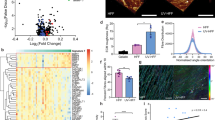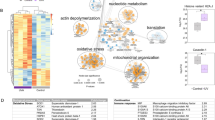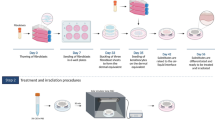Abstract
DAMAGE to skin collagen and elastin (extracellular matrix) is the hallmark of long-term exposure to solar ultraviolet irradiation1–3, and is believed to be responsible for the wrinkled appearance of sun-exposed skin4,5. We report here that matrix-degrading metalloproteinase messenger RNAs, proteins and activities are induced in human skin in vivo within hours of exposure to ultraviolet-B irradiation (UVB). Induction of metalloproteinase proteins and activities occurred at UVB doses well below those that cause skin reddening. Within minutes, low-dose UVB upregulated the transcription factors AP-1 and NF-KB, which are known to be stimulators of metalloproteinase genes6,7. All-transretinoic acid, which transrepresses AP-1 (ref. 8), applied before irradiation with UVB, substantially reduced AP-1 and metalloproteinase induction. We propose that elevated metalloprotein-ases, resulting from activation of AP-1 and NF-KB by low-dose solar irradiation, degrade collagen and elastin in skin. Such damage, if imperfectly repaired, would result in solar scars, which through accumulation from a lifetime of repeated low-dose sunlight exposure could cause premature skin ageing (photoageing).
This is a preview of subscription content, access via your institution
Access options
Subscribe to this journal
Receive 51 print issues and online access
$199.00 per year
only $3.90 per issue
Buy this article
- Purchase on Springer Link
- Instant access to full article PDF
Prices may be subject to local taxes which are calculated during checkout
Similar content being viewed by others
References
Talwar, H. S., Griffiths, C. E. M., Fisher, G. J., Hamilton, T. A. & Voorhees, J. J. J. invest. Dermat. 105, 285–290 (1995).
Lavker, R. M. J. invest. Dermat. 73, 559–566 (1979).
Smith, J. G., Davidson, E. A., Sams, W. M. & Clark, R. D. J. invest. Dermat. 39, 347–350 (1962).
Kligman, L. H. & Kligman, A. M. Photodermatology 3, 215–227 (1986).
Wlaschek, M. et al. Photchem. Photobiol. 59, 550–556 (1994).
Angel, P. et al. Cell 49, 729–739 (1987).
Sato, H. & Seiki, M. Oncogene 8, 395–405 (1993).
Salbert, G. et al. Molec. Endocr. 7, 1347–1356 (1993).
Oikarinen, A., Kylmaniemi, M., Autio-Harmainen, A., Autio, P. & Salo, T. J. invest. Dermat. 101, 205–210 (1993).
Saarialho-Kere, U. K., Pentland, A. P., Birkedal-Hansen, H., Parks, W. C. & Welgus, H. G. J. clin. Invest. 94, 79–88 (1994).
Mauch, C., Krieg, T. & Bauer, E. A. Arch. Dermat. Res. 287, 107–114 (1994).
Eisen, A. Z. J. Invest. Dermat. 52, 442–448 (1969).
Devary, Y., Gottlieb, R. A., Lau, L. F. & Karin, M. Molec. cell. Biol. 11, 2804–2811 (1991).
Angel, P. & Karin, M. Matrix Suppl. 1, 156–164 (1992).
Quinones, S., Buttice, G. & Kurkinen, M. Biochem. J. 302, 471–477 (1994).
Frisch, S. M. & Morisaki, J. H. Molec. cell. Biol. 10, 6524–6532 (1990).
Nicholson, R. C. et al. EMBO J. 9, 4443–4454 (1990).
Yang-Yen, H. F. et al. Cell 62, 1205–1215 (1990).
Schule, R. et al. Cell 62, 1217–1226 (1990).
Pfahl, M. Endocr. Rev. 5, 651–658 (1993).
Fisher, G. J. et al. J. biol. Chem. 269, 20629–20635 (1994).
Weinstein, G. D. & Boucek, R. J. J. invest. Dermat. 35, 227–229 (1960).
Bailly, B. S. et al. J. invest. Dermat. 94, 47–51 (1990).
Rafal, E. S. et al. New. Engl. J. Med. 326, 368–374 (1992).
Hill, P. A. et al. Biochem. J. 308, 167–175 (1995).
Fisher, G. J. et al. J. invest. Dermat. 96, 699–707 (1991).
Hu, C. L., Crombie, G. & Franzblau, C. Analyt. Biochem. 88, 638–643 (1978).
Hibbs, M. S., Hasty, K. A., Seyer, J. M., Kang, A. H. & Mainardi, C. L. J. biol. Chem. 260, 2493–2500 (1985).
Werb, Z., Tremble, P. M., Behrendtsen, O., Crowley, E. & Damsky, C. H. J. Cell Biol. 109, 877–889 (1989).
Murphy, G. et al. Biochem. J. 258, 463–472 (1989).
Author information
Authors and Affiliations
Rights and permissions
About this article
Cite this article
Fisher, G., Datta, S., Talwar, H. et al. Molecular basis of sun-induced premature skin ageing and retinoid antagonism. Nature 379, 335–339 (1996). https://doi.org/10.1038/379335a0
Received:
Accepted:
Issue Date:
DOI: https://doi.org/10.1038/379335a0
This article is cited by
-
Antioxidant activity of Jeju lava seawater through translocation of Nrf2 in human fibroblast
Food Science and Biotechnology (2024)
-
Anti-photoaging effects of canola meal extract on human dermal fibroblasts against UVB-induced oxidative stress
Food Science and Biotechnology (2024)
-
Protective effect of mixture of Acanthopanax sessiliflorum and Chaenomeles sinensis against ultraviolet B-induced photodamage in human fibroblast and hairless mouse
Food Science and Biotechnology (2023)
-
Skin aging from the perspective of dermal fibroblasts: the interplay between the adaptation to the extracellular matrix microenvironment and cell autonomous processes
Journal of Cell Communication and Signaling (2023)
-
Retinoic acid metabolism in cancer: potential feasibility of retinoic acid metabolism blocking therapy
Medical Molecular Morphology (2023)
Comments
By submitting a comment you agree to abide by our Terms and Community Guidelines. If you find something abusive or that does not comply with our terms or guidelines please flag it as inappropriate.



